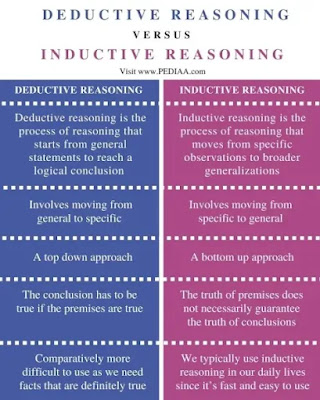What is reasoning? According to Butterworth and Thwaites (2013) reasoning is the process where we move from the knowledge already know and understand to new knowledge and understanding. According to Butterworth and Thwaites (2013) reasoning is a higher skill. It forms the basis for reflection and creative thinking apart from use in critical thinking. They argue that it is bedrock of human advancement. Scientific and academic logic and thinking uses two principal types of thinking; deductive reasoning and inductive reasoning. A third type is abductive reasoning.
Deductive reasoning is a form of valid reasoning. It is sometimes referred to as a "top-down approach". Deductive reasoning works from a general theory or hypotheses, then by examining the possibilities we reach a specific and logical conclusion.
Deductive reasoning is a form of valid reasoning. It is sometimes referred to as a "top-down approach". Deductive reasoning works from a general theory or hypotheses, then by examining the possibilities we reach a specific and logical conclusion by means of testing the possibilities. We can narrow down even further as observations are collected to address the hypotheses. This ultimately leads to the testing hypotheses with specific data. In other words, we start with a general statement or hypotheses in an area of interest and narrow down into more specific hypotheses that we can test. Therefore, deductive reasoning is a top-down reasoning approach. It is more close-ended and narrow in nature and is concerned with hypotheses testing. Deductive reasoning or logic is concerned with the validity of arguments; an argument is deductively valid if and only its conclusion follows a logically necessary consequence of its premises. Usually, deductive reasoning follows the steps of a premise and a second premise and finally an inference or conclusion. A common form of deductive reasoning is called Syllogisms. In syllogisms, there are two statements, a major and a minor premise that reach a logical conclusion. For example, all dogs are mammals. An Alsatian is a dog. Therefore, an Alsatian is a mammal.
Deductive Reasoning:
Source www.socialresearchmethods.net
Inductive reasoning works in the reverse to deductive reasoning. It is a "bottom-up approach " to reasoning. Inductive reasoning makes broad generalisations drawn from specific observations and measures, patterns, regularities are distinguished, some tentative hypotheses are articulated for exploration and investigation, and finally arriving at developing some conclusions or theories, and finally arrive at
constructing some general conclusions or theories.
Therefore, inductive reasoning is a bottom-up approach that uses specific observations and moves to broader generalisations and theories. It uses data , then conclusions are drawn from the data. In inductive reasoning, if the premises are true, then the conclusion is probably true. Inductive reasoning has its place in the scientific method. It is used to form hypotheses and theories. Deductive reasoning is used to apply theories to specific situations.
Inductive Reasoning:
Source www.socialresearchmethods.net
Abductive reasoning is used to address the inherent weaknesses of deductive and inductive reasoning. Specifically, deductive reasoning is criticized for the lack of clarity in terms of how to select theory to be tested via formulating hypotheses. Inductive reasoning, on other hand, criticized because “no amount of empirical data will necessarily enable theory-building”. Abductive reasoning, as a third alternative, overcomes these weaknesses via adopting a pragmatist perspective.
Abductive reasoning:
Source https://research-methodology.net/
Abductive reasoning usually starts with an incomplete set of observations and proceeds to the likeliest possible explanation for the group of observations. It is based on making and testing hypotheses using the best information available. It often entails making an educated guess after observing a phenomenon for which there is no clear explanation.
Abductive reasoning is useful for forming hypotheses to be tested. Abductive reasoning is often used by doctors who make a diagnosis based on test results and by jurors who make decisions based on the evidence presented to them.
In conclusion, reasoning is the basis of logic, creative thinking and critical thinking. Deductive reasoning begins with a general statement or hypothesis and narrows down further as observations are made to address the hypothesis. It is used to test a hypothesis. Inductive reasoning moves from specific observations that lead to broader generalisations and theories. Abductive reasoning starts with an incomplete set of observations and proceeds to the likeliest possible explanation for the group of observations.
References: Butterworth.J and Thwaites.G (2013). Thinking Skills:Critical Thinking and Problem Solving, Second edition. Cambridge, United Kingdom.
Alina Bradford (2017). Deductive vs. Inductive Reasoning
Retrieved from
https://www.livescience.com/21569-deduction-vs-induction.html
Alina Bradford. Deductive vs. Inductive Reasoning
Retrieved from
https://www.youtube.com/watch?v=jX3OXwpEpl8&t=16s
Deduction & Induction Resources. (n.d.). Retrieved from
https://socialresearchmethods.net/kb/dedind.php
Research Methodology. (n.d.). Retrieved from https://research-methodology.net/










No comments:
Post a Comment